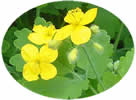Introduction ▲

Greater celandine is a perennial plant whose scientific name is Chelidonium majus. The plant is native to the Mediterranean region of southern Europe, but after the European colonization, was introduced and extended by the new continent, particularly North America.
The greater celandine plant is toxic and can cause severe health problems.
A previous reflection ▲
One issue to keep in mind with all medicinal plants
An observation about a case of severe hepatitis due to the use of material from Greater Celandine reminds us that plant-derived products may involve more risk than people believe. The widespread use of plants for food has reinforced the idea that eating plants promotes health.
With the development of organic chemistry in the nineteenth century has been possible for the first time purify and identify the substances pharmacologically active from plants and subsequently synthesize similar compounds with a more powerful action.
Activity, safety and composition of these substances can be controlled in the same way as purely synthetic substances. However, there are people who believe that traditional plants are better and safer than modern pharmaceuticals. Both qualitative and quantitative composition of these plant derivatives are obtained from what we call alternative medicine that escapes the scope of the legislation established to protect the health of citizens and ensure the effectiveness and safety of the products that are addressed to treat diseases (excerpted from J. van Noordwijk. Ned Tijdschr Geneeskd. 2002 Jan 19, 146 (3) :100-2.).
Distribution ▲
The use of greater celandine plant, despite its Mediterranean origin has been introduced in different cultures and latitudes, from traditional Chinese medicine, which is an important component to North America and South America. However, where use has reached a remarkable extension is in the Slavic countries, especially Russia, Ukraine and Belarus.
Greater Celandine has also come to be used either as a tincture of the rhizome or otherwise, as antispasmodic, against gastroenteritis, pneumonia, pleurisy, various forms of rheumatism and menstrual pain. Popularly, it is used as a resource for pickling for calluses of the feet.
Among the Albanians from northern mountainous areas, the plant has been used to combat jaundice. In Asia, the plant has been used to treat diseases of the liver and bile ducts. Among the settlers who arrived to America was used to treat warts. In other places besides this use, has been used for the papillomas and warts.
Botanical features ▲
It is a perennial plant of medium size and can reach 70-80 cm in height, though often grows to something less. Has yellow flowers with 15 mm in diameter and grayish green pinnate leaves with toothed lobes. There, where the plant grows wild, it is in the cool shady areas, avoiding direct sun-exposed areas.
Flowering:
The celandine has a long flowering period, which begins at the end of the winter season, when the risk of frost disappears until the end of the warm season.
Harvest
The rhizome or root is harvested in the fall. The aerial part were collected during the spring before flowering occurs.
Composition and properties ▲
In the last 40 years there have been added almost thirty different substances at 10 initially known of this plant family of the poppies.
The major metabolites of the plant are isoquinoline alkaloids, of which more than 30 are known. The greatest richness of substances with pharmacological properties are found in the roots, whose alkaloid content is 2-3%. In this organ, predominate coptisine and chelidonine. Also has been shown the presence of other substances with pharmacological properties, as chelidimerine, stylopine, celerythrine, berberine, sanguinarine and others.
The aerial portion of the plant containing an amount of 0.5-1.5% alkaloids. Relatively recently has shown the presence of caffeic acid.
The entire plant is toxic, and contains several alkaloids: The plant, may cause dermatitis, particularly the sap.
Clinical use ▲
Various clinical studies have suggested the potential usefulness of some of the substances contained in the plant or complete extracts thereof in a variety of processes, including childhood's tonsillitis, acquired immunodeficiency syndrome, various tumors and even as antibiotic.
Despite the wide variety of pathology studied, either by the methodological shortcomings of the studies or the small number of cases analyzed, or because they were preliminary studies and observations in animals or in vitro, it is certain that no studies are available that demonstrate beyond any doubt the therapeutic efficacy of the plant or any component of it.
In contrast, there is clinical evidence that the plant can produce acute hepatitis with varying intensity, and in some circumstances, potentially severe hemolytic anemias.
Page updated: December 5, 2008.
WARNING ABOUT THIS CONTENT
The information contained in this website does not replace professional advice and guidance from the attending physician, to whom you should consult before making decisions about your health problems. MEDIZZINE cannot warrant or assume any responsibility for the accuracy or comprehensiveness of the information provided. Conversely, MEDIZZINE recognizes that the information provided is not exhaustive and, therefore, does not expose all of the available information and, in any case, cannot replace information and criteria that your doctor may provide you.